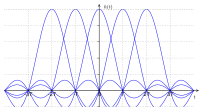
Photo from wikipedia
Through-silicon vias (TSVs) are used as high-speed vertical interconnects between dies in a 3-D system-on-a-chip (SoC). However, their speed cannot be exploited during test application due to inherent limitations of… Click to show full abstract
Through-silicon vias (TSVs) are used as high-speed vertical interconnects between dies in a 3-D system-on-a-chip (SoC). However, their speed cannot be exploited during test application due to inherent limitations of the scan-chains of the cores, which prevent the use of high shift frequencies during the scan-in/out operations. Moreover, due to their high area cost, only a limited number of TSVs can be utilized for test application. As a result, TSVs become the bottleneck for transferring the large volume of test-data to the various layers of the stack, and the time for testing the 3-D chip increases a lot. In this paper, we propose an efficient test-access mechanism (TAM) architecture that exploits the high speed of TSVs to minimize the time for testing 3-D SoCs. The proposed TAM architecture is based on a 2-D time-division-multiplexing approach, and by the means of a very effective test-scheduling method, it offers significant savings in test-time, TSV-count and TAM-cost under power and thermal constraints. Extensive experiments on two 3-D benchmark SoCs show the benefits of the proposed method.
Journal Title: IEEE Transactions on Computer-Aided Design of Integrated Circuits and Systems
Year Published: 2018
Link to full text (if available)
Share on Social Media: Sign Up to like & get
recommendations!